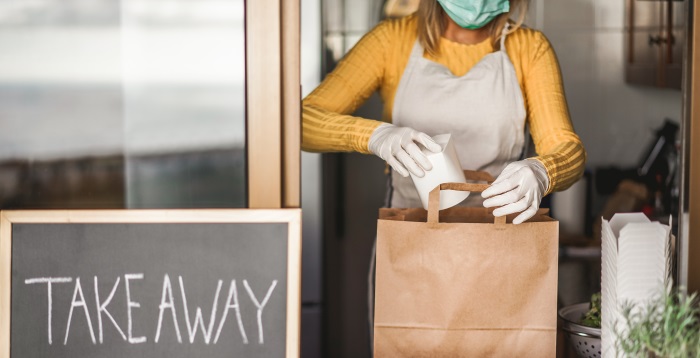National Food Safety Month Week 5: COVID-19 procedures to follow

 Clearly designate a separate area indoors or out where customers can pick up their to-go orders quickly and without contact.
Clearly designate a separate area indoors or out where customers can pick up their to-go orders quickly and without contact.COVID-19 has created so much uncertainty in the world — especially regarding food, dining out, and even ordering takeout from restaurants. It’s always important to follow the highest standards in food safety and that’s emphasized even more today as guests are on the lookout to dine at restaurants that are following safety precautions.
Turn Food Safety Month into Food Safety 24/7; visit our resources page to download posters, activity sheets, and more!
Here are six tips to help reassure guests:
1. Practice social distancing
- Help educate employees and customers on the importance of social distancing through:
- Signs
- Audio messages
- Using every other table and check-out lane to aid in distancing if possible
- For quick-service restaurants, avoid displays that might cause customers to gather; review our guidance for buffets if you serve cafeteria-style; and discourage employee gatherings
- Place floor markings and signs to designate good social distances
- Set up designated food takeout/pickup areas inside or outside the establishment
2. Optimize your takeout and delivery processes
- Encourage customers to opt for contactless deliveries
- Notify customers that their delivery is arriving by text or call
- Establish designated takeout zones for customers
- Offer curbside pick-up
- Offer to place orders in customers’ vehicles for them
- If offering delivery options:
- Ensure coolers and transport containers are clean and sanitized
- Maintain time and temperature controls
- Avoid cross-contamination; for example, wrap food during transportation
3. Train employees on cleaning, sanitizing, and disinfecting procedures
Train employees on these procedures, and protective measures (per the Centers for Disease Control and Prevention and the Food and Drug Administration):
- Have and use cleaning products and supplies using Environmental Protection Agency-approved solvents
- Disinfect high-touch surfaces frequently
- Clean and sanitize food containers
- Prepare and use sanitizers according to label instructions
- Offer customers sanitizers and wipes and designate employees to clean guest areas frequently
4. Understand how to handle employee and customer illness
- Employees - Stay home or leave work if sick; consult a doctor if sick, and contact supervisor
- Employers - Instruct sick employees to stay home; send sick employees home immediately
- Employers – Instruct employees exposed to COVID-19 to stay home and quarantine. If you decide to establish a prescreening policy, consider contacting your insurance carrier for suggestions and retaining a contract nurse for the task. Alternatively, designate an employee in a supervisory capacity to perform the screening who will maintain the confidentiality of the results to the maximum extent possible
5. Wash hands for at least 20 seconds
- Wash your hands often with soap and water for at least 20 seconds
- If soap and water aren’t available, use a 60% alcohol-based hand sanitizer per CDC
- Never touch ready-to-eat foods with bare hands; use single-service gloves or suitable utensils
6. Encourage face coverings
- Per the CDC, face coverings have been shown to be effective tools to mitigate risk from individuals who show symptoms (as well as those who don’t), especially in close environments where it’s hard for people to maintain a 3- to 6-ft. distance. In some states and local jurisdictions, face coverings are required by government officials; some employers require them, too. In all cases, coverings worn by employees should be kept clean in accordance with CDC guidance. CDC provides overall mask cleaning guidance here
- Avoid touching your eyes, nose, and mouth with unwashed hands